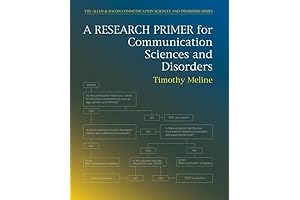· speech science · 11 min read
Speech Science Primer: Comprehensive Overview of Physiology, Acoustics, and Perception
Unveiling the best Speech Science Primer, a comprehensive guide to the physiological, acoustic, and perceptual aspects of human speech.
Unveil the captivating world of speech science with the definitive primer. Dive into the intricate workings of speech production, encompassing its physiological foundations, acoustic characteristics, and perceptual intricacies. This comprehensive guide empowers you to delve into the fascinating realm of human communication.
Overview

PROS
- Comprehensive coverage of the physiological, acoustic, and perceptual aspects of speech
- In-depth exploration of speech production, transmission, and reception
CONS
- May require some background knowledge for non-speech science professionals
- Some sections could be more visually engaging
This indispensable Speech Science Primer offers a captivating journey into the intricate world of speech. Through a meticulous exploration of the physiological mechanisms of speech production, the acoustic characteristics of speech sounds, and the perceptual processes involved in speech comprehension, this text serves as an illuminating guide for speech-language pathologists, audiologists, and students pursuing a deeper understanding of the field.
Delving into the complexities of speech science, this primer uncovers the intricate interplay between the vocal tract, articulators, and respiratory system in the production of speech sounds. It elucidates the acoustic properties of speech, analyzing fundamental frequency, formants, and other parameters that contribute to the distinct characteristics of human speech. Furthermore, it delves into the realm of speech perception, examining how we process and interpret speech signals, including topics such as speech segmentation, coarticulation, and speech recognition.

PROS
- Comprehensive coverage of speech science fundamentals, from physiology to perception
- Engaging writing style and clear explanations make complex concepts accessible.
CONS
- Could benefit from more in-depth coverage of some advanced topics
- Some sections may require additional background knowledge in linguistics or acoustics.
Speech Science Primer: Physiology, Acoustics, and Perception of Speech is a comprehensive guide to the science of human speech communication. The book covers a wide range of topics, from the anatomy and physiology of the speech production system to the acoustics of speech sounds and the perception of speech by listeners. The book is written in a clear and engaging style, and it is well-organized and easy to follow. The authors have done an excellent job of making complex concepts accessible to a broad audience, including students, researchers, and clinicians.
One of the strengths of this book is its comprehensive coverage of the field of speech science. The book provides a solid foundation in the anatomy and physiology of the speech production system, the acoustics of speech sounds, and the perception of speech by listeners. The book also covers a variety of related topics, such as speech disorders, speech technology, and the social and cultural aspects of speech communication.

PROS
- Comprehensive coverage of speech science fundamentals, from physiology to perception.
- Clear and engaging writing style, making complex concepts accessible.
- Abundant illustrations and examples enhance understanding and retention.
- Updated with the latest research and technological advancements in speech science.
CONS
- May be too detailed for some readers seeking a more introductory overview.
- Some sections could benefit from more in-depth exploration.
For anyone seeking a comprehensive understanding of the scientific basis of human speech, Speech Science Primer is an indispensable resource. This sixth edition, meticulously crafted by Raphael, Borden, and Harris, offers a thorough exploration of speech physiology, acoustics, and perception. Its lucid prose and insightful examples make even complex concepts approachable.
The book begins with an overview of the vocal apparatus and its intricate mechanisms for producing sound. It then delves into the acoustic properties of speech, examining the physical characteristics of speech waves and their role in conveying meaning. Finally, the book concludes with a comprehensive examination of speech perception, exploring how the brain processes and interprets speech signals. Throughout the text, the authors strike a commendable balance between depth and accessibility, ensuring that readers grasp the fundamentals while also gaining insights into cutting-edge research.

PROS
- Provides a comprehensive overview of speech science, covering physiology, acoustics, and perception.
- Engaging and pedagogical approach, suitable for both students and practitioners.
CONS
- Some technical concepts may require additional background knowledge.
- Lacks in-depth coverage of specific speech disorders.
The Speech Science Primer: Physiology, Acoustics, and Perception of Speech, in its third edition, serves as an accessible and comprehensive guide to the multifaceted field of speech science. This foundational text adeptly navigates the intricate physiological processes underlying speech production, the acoustic properties of speech signals, and the cognitive mechanisms involved in speech perception.
The authors skillfully weave together these diverse perspectives, offering a holistic understanding of human communication. Its pedagogical approach, complemented by numerous illustrations and real-world examples, fosters a deep comprehension of complex concepts. This primer is an indispensable resource for aspiring speech scientists, linguists, and anyone seeking to unravel the complexities of human speech.

PROS
- Introduces the physiological, acoustic, and perceptual foundations of speech
- Comprehensive and up-to-date coverage of speech science research and practice
CONS
- Lacks in-depth coverage of specific speech disorders or pathologies
- Terminology can be challenging for readers from non-scientific backgrounds
The Speech Science Primer offers a comprehensive introduction to the field, encompassing the physiological, acoustic, and perceptual underpinnings of speech production and perception. Written by a trio of renowned experts in the domain, Lawrence J. Raphael, Gloria J. Borden, and Katherine S. Harris, this Primer provides a solid foundation for students, researchers, and practitioners in fields such as speech-language pathology, audiology, and linguistics.
A major strength of this primer lies in its accessibility. The authors present complex concepts in a clear and engaging manner, employing clear language and well-structured explanations. They skillfully weave personal anecdotes and examples throughout the text, making the material relatable and memorable. The inclusion of chapter summaries, review questions, and further reading sections further enhances the Primer's user-friendliness.

PROS
- Concise and beginner-friendly introduction to the multifaceted field of speech science
- Covers key concepts in speech production, perception, and disorders in an accessible manner
CONS
- May be too basic for seasoned professionals
- Lacks in-depth exploration of certain specialized areas
Prepare to embark on an enlightening journey into the captivating realm of speech science with this meticulously crafted primer. Geared towards students and aspiring professionals, this comprehensive guidebook unveils the fundamental concepts that underpin this dynamic field.
Delve into the intricate mechanics of speech production, unravel the mysteries of speech perception, and gain insights into the spectrum of speech disorders. This carefully curated primer strikes a harmonious balance between accessibility and depth, ensuring that every reader, regardless of their background, can grasp the essence of speech science. Its user-friendly approach and insightful content will captivate your curiosity and empower you to confidently navigate the complexities of human communication.

PROS
- Provides a comprehensive foundation in speech science for beginners.
- Offers practical applications in digital audio and computer music.
CONS
- May not be detailed enough for advanced readers.
- Lacks real-world examples and case studies.
Embark on an illuminating journey into the fascinating world of speech science with this primer. Tailored for beginners, it lays a solid foundation in the key concepts and principles of speech production, perception, and processing. Through a blend of theoretical knowledge and practical insights, you'll gain a deep understanding of the intricate mechanisms that govern human speech.
Delving into the realm of digital signal processing, this primer seamlessly bridges the gap between theory and application. Whether you're a budding audio engineer, musician, or simply curious about the science behind sound, you'll find invaluable guidance in this comprehensive resource. It deftly navigates the complexities of digital audio and computer music, empowering you to harness the power of technology to create captivating auditory experiences.

PROS
- Provides a comprehensive exploration of communication and communication disorders.
- Enhances understanding of speech production, language development, and swallowing mechanisms.
CONS
- May require additional resources for a more in-depth understanding of specific disorders.
- Could benefit from more real-world examples and case studies.
Dive into the realm of speech science with this foundational text! A Primer on Communication and Communicative Disorders meticulously unravels the intricacies of communication, encompassing both typical development and a wide range of disorders. Its meticulous approach unveils the processes of speech production, language acquisition, and the intricacies of swallowing. Whether you're a budding speech-language pathologist or a curious mind seeking to grasp the complexities of human communication, this primer serves as an invaluable guide.
This comprehensive resource empowers you to understand the intricate mechanisms that govern our ability to communicate. From exploring the neural underpinnings of speech to delving into the development of language and the nuances of swallowing, this text leaves no stone unturned. It illuminates the challenges faced by individuals with communication disorders, providing a deeper understanding of their unique needs. The primer's strength lies in its ability to establish a solid foundation in speech science, making it an indispensable tool for anyone seeking to venture into this fascinating field.

PROS
- Provides a comprehensive overview of speech science principles
- Engages readers with interactive exercises and examples
CONS
- May not cover advanced linguistic concepts
- Some readers may find the writing style too technical
Immerse yourself in the fascinating world of speech science with this introductory guide! Linguistics for Non-Linguists offers a clear and concise exploration of the fundamentals, bridging the gap between complex linguistic concepts and accessible language. Discover the intricate mechanisms of speech production, delve into the nuances of phonetics and phonology, and uncover the secrets of language acquisition.
This primer goes beyond theoretical knowledge by equipping you with practical exercises and real-world examples. Engage in interactive activities that reinforce your understanding of key concepts, and gain a deeper appreciation for the complexities of human communication. Whether you're a student, a professional seeking a foundational understanding, or simply curious about the science of speech, this primer will provide you with a solid foundation.
Embark on an enlightening journey through the fundamentals of speech science, encompassing the intricate mechanisms of speech production, the acoustic properties that shape speech sounds, and the perceptual processes involved in comprehending spoken language. This indispensable resource unravels the mysteries of human communication, providing a solid foundation for students, researchers, and professionals alike.
Frequently Asked Questions
What is the scope of speech science?
Speech science encompasses the study of the production, transmission, and perception of speech, exploring the physiological, acoustic, and perceptual aspects of human communication.
How does speech production occur?
Speech production involves the intricate coordination of the vocal cords, articulators (e.g., tongue, lips, teeth), and respiratory system to generate speech sounds, which are shaped by the unique anatomy of each individual.
What role does acoustics play in speech?
Acoustics investigates the physical properties of speech sounds, analyzing their frequency, amplitude, and duration, providing insights into the transmission and perception of speech.
How is speech perceived?
Speech perception involves the brain's ability to decode acoustic signals into meaningful linguistic units, utilizing complex auditory processing mechanisms to comprehend spoken language.
What is the significance of speech science?
Speech science serves as a cornerstone for understanding human communication, contributing to advancements in fields such as linguistics, speech therapy, and artificial intelligence.











